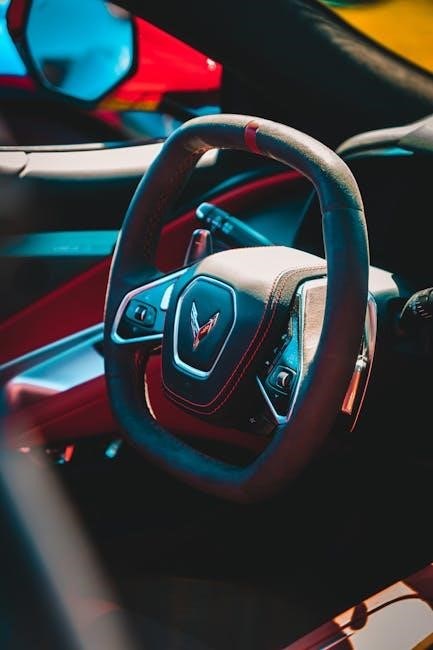Learning manual driving varies widely‚ with some mastering basics in minutes and others needing months․ On average‚ it takes about a week to feel comfortable‚ progressing from stalling to smooth gear transitions over time․
Why Learning Manual Driving is Important
Learning manual driving enhances control over the vehicle‚ improving connection with the road․ It boosts fuel efficiency and reduces wear on the car․ Many high-performance vehicles require manual skills‚ making it essential for enthusiasts․ Understanding manual driving also fosters a deeper appreciation for automotive mechanics․ Additionally‚ it prepares drivers for emergencies and offers better handling in challenging conditions․ Mastering manual driving is a valuable skill that promotes confidence and versatility behind the wheel‚ making it a worthwhile investment of time and effort for any driver;
Understanding the Basics of Manual Transmission
A manual transmission‚ also known as a stick-shift‚ requires the driver to manually change gears using the clutch pedal and gearshift․ The clutch pedal disconnects the engine from the transmission‚ allowing smooth gear changes․ The gearshift selects the desired gear‚ while the accelerator controls engine RPM to prevent stalling․ Proper coordination between these components is essential for seamless driving․ Understanding how gears relate to speed and torque is fundamental․ Practice is key to mastering the feel of the clutch and smooth transitions between gears‚ laying the groundwork for proficient manual driving․

Factors Affecting the Time to Learn Manual Driving
Factors such as coordination‚ practice frequency‚ starting conditions‚ and prior experience with automatic vehicles significantly influence the time required to learn manual driving effectively and consistently․

Coordination and Dexterity Requirements
Manual driving requires precise coordination between the clutch‚ accelerator‚ and gearshift‚ demanding good hand-eye coordination and fine motor skills․ Learners must synchronize pressing the clutch with accelerating smoothly‚ which can feel awkward at first․ Those with higher dexterity and coordination often pick up these skills faster․ Challenges like stalling or jerking motions are common due to misalignment in timing and pressure․ Regular practice helps improve muscle memory‚ reducing errors over time․ The ability to multitask while maintaining focus on the road also plays a significant role in mastering these physical demands efficiently․
Frequency and Quality of Practice
Consistent and high-quality practice significantly impacts the time it takes to learn manual driving․ Regular sessions‚ even if short‚ help build muscle memory faster than irregular or lengthy practices․ Ideally‚ learners should practice 2-3 times a week‚ focusing on specific skills like shifting gears smoothly or controlling the clutch․ Quality practice involves being mindful of each action‚ such as feathering the clutch or matching engine speed to gear transitions․ Focused practice in a controlled environment‚ like an empty parking lot‚ accelerates progress․ Over time‚ this dedication reduces stalling and improves overall control‚ leading to confidence behind the wheel․
Starting Conditions (Flat Ground vs․ Inclines)
Starting on flat ground is ideal for beginners‚ as it reduces the complexity of managing the clutch and accelerator․ Flat surfaces allow learners to focus on smooth gear transitions without the added challenge of preventing the car from rolling backward․ In contrast‚ starting on inclines demands immediate mastery of balancing the clutch and brake‚ which can be overwhelming․ Practicing on flat ground first builds foundational skills‚ such as clutch control and acceleration‚ before progressing to inclines․ This gradual approach minimizes frustration and stalling‚ allowing learners to adapt to more challenging conditions confidently․
Prior Experience with Automatic Vehicles
Drivers with experience in automatic vehicles often have an advantage when learning manual driving‚ as they are already familiar with basic driving concepts like steering‚ braking‚ and acceleration․ However‚ they must still dedicate time to mastering the clutch and gear shifting; The transition requires adapting to the manual gearbox‚ which adds a layer of complexity․ While their existing driving knowledge can shorten the learning curve‚ they must focus on coordinating the clutch and accelerator smoothly․ This prior experience provides a foundation but does not eliminate the need for practice to develop muscle memory for manual driving skills․

Initial Learning Phase
The initial learning phase involves understanding the clutch and accelerator relationship; It typically takes a few days to a week; Focus on clutch and accelerator coordination‚ starting in a safe‚ flat area․ Practice basic gear shifts until smooth․
Getting Comfortable with the Clutch and Accelerator
Mastering the clutch and accelerator is the foundation of manual driving․ It requires coordination to press the clutch fully‚ shift gears smoothly‚ and release gradually while pressing the accelerator․ Start in a flat‚ open area to minimize stalling․ Practice short movements‚ focusing on the “biting point” where the engine engages․ Small‚ controlled accelerator inputs help avoid jerking․ Most learners take a few hours to a few days to feel comfortable with this basic coordination․ Consistent practice builds muscle memory‚ making the process second nature over time․

Mastering the Basic Gear Shifts
Mastering basic gear shifts is a key part of learning manual driving․ It involves understanding the gear shift pattern‚ pressing the clutch fully‚ and shifting smoothly between gears․ Practice in a safe‚ empty area to minimize stalling․ Coordinate clutch release with accelerator input for smooth transitions․ Timing shifts based on speed and RPM is crucial․ Most learners master basic shifts within a few days to a week with consistent practice․ Focus on shifting sequentially and listening to engine cues to refine your technique․ Regular practice in a controlled environment helps build confidence and skill․

Understanding the Relationship Between Gears and Speed
Understanding how gears relate to speed is vital for mastering manual driving․ Lower gears provide more torque for acceleration‚ while higher gears are for maintaining speed․ First gear is for starting from a standstill‚ second for low-speed maneuvers‚ and higher gears for cruising․ Shift gears based on speed and RPM to avoid engine strain or loss of power․ Practice matching gears to speed helps maintain smooth control and prevents stalling․ This understanding enhances driving efficiency and safety‚ especially on varied terrain like hills or highways․ Coordination between speed‚ gear selection‚ and clutch use improves with practice․

Building Muscle Memory
Building muscle memory requires regular practice‚ helping drivers shift gears and use the clutch instinctively․ Consistent repetition over weeks makes these actions second nature․
Consistent Practice and Repetition
Consistent practice is crucial for developing muscle memory when learning manual driving․ Regular repetition of clutch and gear operations helps build instinctive control․ Aim for short‚ frequent sessions rather than lengthy‚ sporadic ones․ Even 15-20 minutes daily can yield progress faster than one or two long practices weekly․ Focus on smooth‚ deliberate movements‚ gradually increasing speed as coordination improves․ Over time‚ the brain and body adapt‚ making gear shifts and clutch engagement second nature․ Quality practice in a safe‚ controlled environment accelerates mastery‚ reducing the time to achieve proficiency․

Gradually Increasing Difficulty (Traffic‚ Hills‚ etc․)
As skill and confidence grow‚ introducing challenging conditions helps refine control․ Start with empty parking lots‚ then progress to quiet streets‚ and eventually tackle busy traffic․ Hills present a unique challenge‚ requiring precise balance between clutch and accelerator․ Practice on flat ground first‚ then gradually incorporate inclines․ Exposure to varied scenarios builds adaptability and reduces hesitation․ Most learners can handle moderate traffic within 1-2 weeks of regular practice‚ while mastering hills and complex conditions may take 2-4 weeks․ Consistent exposure to increasing difficulty accelerates the learning process‚ ensuring smooth transitions in real-world driving situations․
Timeframe for Developing Muscle Memory
Developing muscle memory for manual driving typically takes 2-4 weeks of consistent practice․ During this period‚ the brain and body synchronize clutch‚ accelerator‚ and gearshift actions․ Daily practice‚ even for short sessions‚ accelerates this process․ Individuals with good coordination may adapt faster‚ while others may need more time․ The key is repetition‚ as frequent practice solidifies neural pathways․ By the end of this phase‚ shifting gears and balancing the clutch become second nature‚ enabling smoother and more confident driving․ Patience and regular practice are essential for embedding these skills into long-term muscle memory․

Intermediate Skills Development
Intermediate skills development in manual driving involves refining gear transitions and improving control․ This phase typically takes 2-3 weeks with regular practice․
Smoothing Out Gear Transitions
Smoothing out gear transitions is a critical intermediate skill that enhances driving comfort and control․ It typically takes 1-2 weeks of consistent practice to master․ Focus on coordinating the clutch pedal and accelerator smoothly‚ ensuring seamless shifts between gears․ Practice in different conditions‚ such as uphill or downhill‚ to refine your technique․ Pay attention to listening to engine sounds to gauge optimal shift points․ Regular repetition helps develop muscle memory‚ making gear transitions feel natural and effortless over time․ This skill is foundational for advancing to more complex driving scenarios․
Learning to Downshift and Brake Effectively
Mastering downshifting and braking is essential for safe and efficient manual driving․ It typically takes 1-3 weeks of practice to become proficient․ Downshifting before braking helps maintain control and reduces wear on the vehicle․ Practice using engine braking by downshifting before applying the brakes‚ especially on inclines․ Smooth transitions between gears and brakes are key to avoiding jerky stops․ Regular practice in low-traffic areas can help refine this skill․ Proper downshifting and braking techniques ensure smoother stops and better control‚ particularly in challenging conditions like hills or when carrying heavy loads․
Handling Various Driving Conditions
Adapting to different driving environments is crucial for mastering manual driving․ Rain‚ snow‚ hills‚ and traffic require precise control over the clutch and accelerator․ Smooth gear transitions and adjusting speed according to conditions are vital․ Practicing in controlled settings helps build confidence․ Over time‚ drivers learn to instinctively adjust their technique‚ ensuring safety and efficiency in any situation․ Mastery of these skills enhances overall driving proficiency and reduces the learning time for manual driving‚ making the process more manageable and enjoyable as one gains experience․

Advanced Skills and Mastery
Advanced techniques‚ like perfecting hill starts and high-speed shifting‚ refine control and confidence․ Mastery typically takes 2-6 months of consistent practice‚ ensuring smooth‚ instinctive operation․
Perfecting Hill Starts and Uphill Driving
Mastering hill starts and uphill driving requires precise coordination of the clutch‚ accelerator‚ and brakes․ It often takes several weeks of consistent practice to achieve smooth‚ controlled starts without rolling back․ Using the handbrake effectively and understanding the “bite point” of the clutch are crucial․ Uphill driving demands constant gear adjustments to maintain speed and control‚ especially on steep inclines․ Regular practice on varying terrains helps build adaptability․ Most learners can refine these advanced skills within 2-4 months‚ leading to greater confidence and mastery of challenging road conditions․
Mastering High-Speed Shifting and Control
High-speed shifting requires seamless coordination between the clutch‚ accelerator‚ and gearstick․ Smooth transitions are key to maintaining control and stability at higher speeds․ Learners typically refine this skill after several months of consistent practice․ Matching gear shifts to speed and engine RPMs becomes intuitive over time‚ enhancing both control and fuel efficiency․ Regular practice on highways or open roads helps build confidence and precision․ Mastering this skill not only improves driving safety but also reduces wear on the vehicle․ Achieving proficiency in high-speed shifting is a milestone in becoming a skilled manual driver․
Time Required for Complete Proficiency
Achieving complete proficiency in manual driving typically takes around 6 months to a year of consistent practice․ This timeframe varies depending on individual aptitude‚ frequency of practice‚ and the complexity of driving conditions encountered․ Regular practice‚ even for short sessions of 15–30 minutes‚ accelerates progress․ Learners with prior experience in automatic vehicles may grasp manual driving faster․ Complete mastery involves smooth gear transitions‚ confident control in all scenarios‚ and instinctive decision-making․ With dedication and exposure to diverse driving situations‚ most drivers reach an advanced level of skill within a year‚ becoming fully confident and competent behind the wheel․
Common Challenges and Solutions
Mastering manual driving involves overcoming stalling‚ jerky starts‚ and coordinating clutch-accelerator control․ Consistent practice‚ patience‚ and focusing on smooth transitions help build confidence and skill effectively over time․
Overcoming Stalling and Jerking
Stalling and jerking are common challenges when learning manual driving․ These issues often arise from poor clutch control‚ incorrect gear selection‚ or uneven acceleration․ To address this‚ practice the “biting point” of the clutch‚ where it begins to engage․ Start on flat ground and gradually shift to inclines․ Focus on smooth‚ gradual acceleration and avoid sudden movements․ Patience and consistent practice are key․ Over time‚ muscle memory will reduce stalling incidents‚ and smoother transitions will minimize jerking․ Remember‚ these are normal hurdles that every learner faces‚ and persistence will lead to improvement․
Building Confidence in Different Scenarios
Building confidence in various driving scenarios is crucial for mastering manual driving․ Start by practicing in low-pressure environments like empty parking lots to hone basic skills․ Gradually expose yourself to more challenging conditions‚ such as inclines or light traffic‚ to adapt to different situations․ Focus on smooth clutch engagement and gear transitions‚ especially when encountering hills or busy intersections․ Practice merging onto highways and navigating heavy traffic to improve quick decision-making․ Stay calm and learn from mistakes—consistent practice in diverse scenarios will enhance your ability to handle any situation with ease and confidence;
Tips for Accelerating the Learning Process
To accelerate learning manual driving‚ practice consistently and focus on smooth clutch-accelerator coordination․ Start in a safe‚ open area like an empty parking lot to build foundational skills without pressure․ Focus on gradual‚ controlled movements when shifting gears and releasing the clutch․ Practice shifting gears at different speeds to understand when to engage each gear․ Incorporate short‚ frequent practice sessions rather than lengthy ones to maintain focus and avoid burnout․ Lastly‚ consider learning from an experienced driver or instructor for personalized feedback and guidance․
Mastering manual driving requires patience and practice․ It may take weeks for some‚ but with persistence‚ you’ll become proficient in due time․
Final Thoughts on Learning Manual Driving
Learning manual driving is a journey that requires patience‚ persistence‚ and practice․ While the timeframe varies‚ consistent effort leads to mastery․ Start with small goals‚ celebrate progress‚ and stay committed․ Embrace challenges as opportunities to improve․ Remember‚ every driver began somewhere‚ and with dedication‚ you’ll become proficient․ Don’t rush the process—enjoy the learning curve and the sense of accomplishment it brings․ Keep practicing‚ and you’ll soon feel confident behind the wheel․
Encouragement and Next Steps
Mastering manual driving is a skill that opens up new freedoms and confidence․ Celebrate small victories‚ like smooth gear shifts or clutch control‚ to stay motivated․ As you progress‚ challenge yourself with varied driving conditions․ Set achievable milestones‚ such as driving in traffic or on hills‚ to track improvement․ Stay positive and remember that practice is key․ Seek feedback from instructors or experienced drivers to refine your skills․ With persistence‚ you’ll become a proficient manual driver‚ ready to take on any road with confidence․
